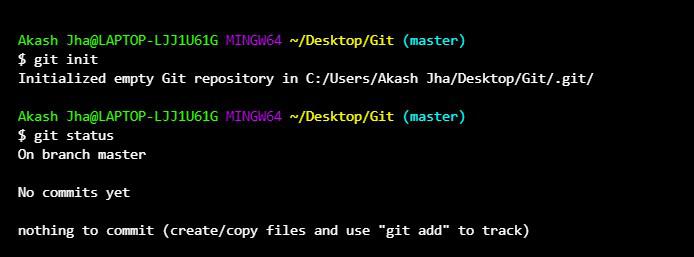What is Git Init?
Last Updated :
11 Jan, 2024
Git is a Distributed version control system to track the changes in the source code. Git is free and open-source software. Version Control Systems are software tools for tracking and managing all the kinds of changes made to the source code during the development of the project. It also gives us the power to turn back to the previous version of the source code if by chance any mistake is made.
Git init
The main purpose of the git init command is to initialize the new working environment or a new git repository to work on a new project. Before performing the git init command git will not track the files that are in the system it will start to track only when you initialize the git init command form there you can commit the files and push them to the remote repository.
Following is the command that is used in the initializing environment in the git.
git init
Git init Options and Usage
Following are the someone options that can be used with the git init command.
- initialize the repository in the specific directory by giving the path.
- git –bare will initialize the bare repository it will not consist of any working directory it is used to share the file between the users.
- git init –q will remove the unnecessary outputs during the git initialization.
- git init –shared you can the repository between multiple users if you create by using this command.
Custom Git init Directory Environment Values
You can set the custom environmental variables during the git init as shown in the following for Linux, and macOS.
The command used to set the environment variables in git is “env“.
Example of an Environment Values
env GIT_AUTHOR_NAME="Your Name" \
GIT_AUTHOR_EMAIL="GFG.email@example.com" \
Git init vs. Git clone
|
Git Init will intialize the new git repository.
|
Git clone will clone the new git repsoitory in to the local machine.
|
|
Git init will sets up complet new repository which will contains all git files and directories required.
|
Used to clone the repository which is avalible in the remote git repository to the local machine.
|
|
You can start the tracking of files by adding them to the staging area and committing to the repository.
|
Once the repository is cloned you can start working on it.
|
Git init Bare Repositories
The bare git repsoitory doesn’t contsain the working directory it is mainly used for the collaboration of developers to perform the push and pull operations. Bare repositories is mainly used for the storing the metadata and the version hsitory of the repositories.
Following is the command which is used for the intiliaizing the git bare repsository
git init –bare <Name of the repository>
Git bare repsoitories are mainly used as the central repository from where the other developers can push and pull the repsoitories.
Git init Templates
Before intializing the git repostory you can describe the state or you can get the custmized repository with the help of git templates. You can standaridze the repository before it is going to create which will automate you so many tasks like creating files like README file or adding a .gitignore file.
How to set up Git?
Firstly, you need to go to your required folder and run the git init command to initialize a new git repository, and then after you can use the git status command to check the files in your Working Tree and in the Staging Area. You cannot see anything below the image coz there is no file in the working tree or staging area.

What is the Staging area in Git?
The staging area is the preview of your next commit. When you create a git commit, Git automatically takes changes that are in the staging area and makes them a new commit. You can add and remove changes from the staging area. But if you add a file let’s say “file.txt” then it is an untracked file and now if you execute git status then it is shown in red color.

If you run the git status command without running git init you will get an error.
How to create an empty Git repository in the specified directory?
For this, use the command: git init <directory>
Running this command will create a new subdirectory called containing nothing but the .git subdirectory.
git init –bare <directory>
The –bare flag creates a repository that doesn’t have a working directory, making it impossible to edit files and commit changes in that repository. You would create a bare repository to git push and git pull from, but never directly commit to it.
git init <directory> –template=<template_directory>
Templates allow you to initialize a new repository with a predefined .git subdirectory. You can configure a template to have default directories and files that will get copied to a new repository’s .git subdirectory.
Frequently Asked Question On the Git Init
What is Local Repository?
The Local Repository is everything in your .git directory. Basically, your local repository contains all of your checkpoints and commits.
What is Remote Repository?
Remote repositories are the versions of your project work that are hosted on the Internet or network somewhere around the world.
What is the difference between local and remote repository?
Local repositories reside on the computers of team members. On the contrary, remote repositories are hosted on a server that is accessible to all team members.
What is Distributed Version Control System?
It is a kind of version control system abbreviated as DVCS where the entire version history of the whole codebase is mirrored on every developer’s computer.
Share your thoughts in the comments
Please Login to comment...